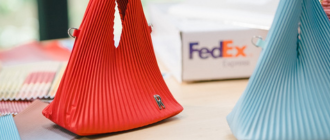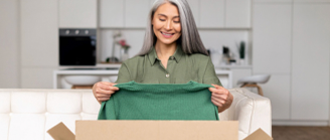
How Aire’s Nivedita Venkateish Is Building A Brand For Seniors, With Seniors
By FedEx | November 25, 2025
After seeing her grandmother struggle with uncomfortable adult diapers, Nivedita Venkateish invested a six-figure sum to launch Aire, a brand specializing in incontinence products that empower seniors. Here, she shares how she serves and engages silver consumers through online and offline channels.
For over a decade, Nivedita Venkateish built a high-flying career at major international companies like Kraft Heinz and Meta. At 33, she pivoted from working with cutting-edge tech like artificial intelligence to tackling a very different kind of AI: adult incontinence.
Across Asia, about 14.5% of people suffer from urinary incontinence, yet the condition still carries stigma. Nivedita’s own grandmother had incontinence but refused to wear adult diapers, which meant she had to make frequent trips to the toilet at night. One evening, while disoriented from COVID-19, she fell and became bedridden for months.
When her grandmother eventually began using incontinence products, Nivedita realized they were expensive, uncomfortable, and lacked personality. Determined to raise the bar for elderly care, she launched Aire, investing a six-figure sum to build a Singapore brand of adult diapers designed to empower seniors with greater comfort and confidence. Aire’s incontinence wear is also tailored to Asian body types and made without latex, lotions, or fragrances to help prevent rashes.
As populations across Asia Pacific age rapidly, young entrepreneurs like Nivedita are driving innovation in the silver economy to meet growing elderly care needs. We spoke with the founder, who recently served as a judge at the 2025 FedEx/JA International Trade Challenge, to learn more about her journey of building trust and connecting with silver consumers.
The journey to launching a new business is never easy. What did it take for you to build Aire from scratch?
Nivedita Venkateish: It took a giant leap of faith. I started Aire at a specific juncture in my life: I had spent more than a decade in MNCs – from Diageo and Kraft Heinz to Meta – and had also dabbled with working at start-ups. I could easily have returned to the corporate world – in fact, I had a job offer at that time. But I decided to take a leap of faith on myself and my idea.
At that time, many folks ridiculed the idea of Aire. I was at Meta before launching the business, so the idea of going from AI (artificial intelligence) to AI (adult incontinence) was one that most folks found laughable. However, I knew I was energized to serve this segment of the population: older people who had traditionally been ignored by consumer brand-building efforts. Through my conversations with them, their challenges really resonated with me and made me determined to throw my hat in the ring.
When you start out, there are many folks keen to share opinions on how things won’t work out. My advice is to find the few who lift you up, and don’t take everyone’s opinions into account.
Right now, we’re still an early-stage start-up. We’re very much in a constant stage of hustling. However, the best part is that I don’t have to do it alone. I have the company of a small but driven team who are committed to building a well-loved brand for older adults in Asia.
Your target audience includes aging consumers and those buying on behalf of loved ones. How do you ensure the online shopping experience is accessible to both groups? What insights have you gained about silver shoppers that surprised you?
Great question. Our focus has always been to build a brand for seniors and with seniors. There are a number of brands that exist to champion caregivers, and while this is a noble mission as well, our focus is different.
For too long, seniors have been underrepresented by brands. In fact, the largest study on this subject in the UK concluded that 90% of seniors aged over 65 felt that brands don’t speak for them – or worse still, stereotype them. Seniors are a valuable consumer group that accounts for a quarter of Singapore’s population. However, most communication targeting seniors feels clinical, outdated, or paints them as helpless.
The seniors we interact with are delightfully diverse in their likes, dislikes, and hobbies. I know a 70-year-old ballroom dancer who goes to his swing class every week without fail, an octogenarian with a black belt in karate, and an AI-obsessed 75-year-old lady who has created avatars for herself and her whole family.
Another common stereotype is that seniors aren’t tech savvy – which simply isn’t true. Seniors are spending increasing amounts of time not only on platforms like Facebook, but also on TikTok and Shopee. They are very savvy with online marketplaces and love a good deal. If you win them over, they will be powerful ambassadors for the brand.
How much of your sales come from online vs. offline? How do you decide which channel to prioritize?
We were very passionate about being omnichannel as soon as we could. Our yardstick is to go where our customers want us to be and let them guide us on which channels to prioritize. Many customers have written to us or called us, asking for certain touchpoints they want us to include – and we try our best to make it happen.
Being in retail is a very expensive affair and most D2C startups either can’t or don’t want to make the heavy investments that come with it. But for us, it was necessary so that customers could see, touch, and feel our products.
Customers have recently been asking us to make our products available at nursing homes as well. That’s something we’re working to figure out!
Many e-commerce brands rely heavily on social media, but this product category isn’t easily “Instagrammable”. How do you approach marketing and customer acquisition for such a niche product?
As compared to many millennial and Gen Z D2C brands that rely on lifestyle shots and being on-trend, we have to be more thoughtful and measured.
Our marketing focuses on education and information because the first step for many folks is to begin acknowledging they have a problem with urine leaks. That’s why our marketing centers on ensuring people don’t feel isolated. We want them to understand that it’s a common condition and there are ways to manage incontinence and safeguard your way of life.
In retail stores, we do a lot of marketing to allow customers to touch and feel the product – so they know that when we say it’s cottony soft, it really is! This also helps them understand how the product works, because despite adult incontinence affecting 400 million people worldwide, it’s still so heavily stigmatized that folks don’t know enough about it.
Additionally, one goal we have is to share the spotlight by having our senior customers become the faces of our content. But we’ve struggled to find folks willing to be in front of the camera. Many of our senior customers are very happy to chat in person, on WhatsApp, or one-on-one – in fact, I have customers who message or call me daily. But the moment it comes to being on camera, they’re incredibly reluctant.
We’ve had to work around this, finding creative ways to communicate their personality and messages through proxies. But I’m really hopeful that once we overcome more of the stigma around this product category, I’ll be able to convince one of my lovely senior customers to give it a go.
What’s one belief you hold that other business leaders might disagree with?
There is no proxy to being in the weeds in the early stages – whether it’s answering customer questions, replying to reviews, packing samples, or going door-to-door to make sales and set up displays.
Being in the weeds means you have the deepest possible understanding of your customers and consumers. While this may not be sustainable to the same degree as the business scales, there is no alternative if you want to build trust with your customers as well as your team.
A lot of folks think I’m crazy because I answer all my customers’ WhatsApp messages and calls. But to me, it just means I can truly be of service to them. And I’ll keep doing it for as long as I can!
Describe the greatest business failure that you treasure the most.
Honestly, there are a dozen failures that happen daily and double the number of fires. I strongly believe it’s about progress, not perfection, and that’s something I’m still learning to be okay with.
I think the biggest lesson I’ve learned is that folks will surprise you with their kindness. I’m forever in debt to our first customer, who sent us a one-page review via email – just when I was wondering if I’d made the totally wrong decision in starting Aire. To this day, I’m still in touch with them.
I’m also grateful to our partners, who didn’t need to take the bet on us, but still did when we were nothing. And I’m thankful for my team who’s been with us for years, wearing many hats and rolling up their sleeves to get things done without the bragging rights or benefits of working at larger companies.
So while no specific failure comes to mind, the learning I treasure the most is to keep trying. The effort will be worth it at some point.
What was the initial investment behind launching Aire?
I invested a six-figure sum into launching Aire. Since then, we’ve raised two rounds of additional funding led by DSG Consumer Partners, the most respected consumer venture fund in the region. Aire was their first investment into the silver space. We’ve also had support from WV Fund II and AngelCentral who have been incredible thought partners and have a shared understanding of our mission and vision.
So far, what growth milestones have you achieved?
Since launch, we have expanded our portfolio across multiple product ranges. We’ve added incontinence products for the heaviest of overnight leaks, since nocturia – or frequent night-time urination – is the top cause of falls amongst the elderly. We’ve also expanded our distribution footprint to cover close to 200 points of sale, from traditional retail to hospital pharmacies to online channels.
What’s next for Aire? Are you considering expanding beyond Singapore?
Yes, we will be launching in Malaysia very shortly! We’re embarking on this expansion in response to customer requests, and we’re incredibly grateful for their support.
Our north star has always been to deeply understand the market and our target consumers before expanding. These three years in Singapore have taught us a lot and we’re very excited to bring these learnings into a new market – while learning about and from our Malaysian customers!
SHARE THIS STORY
- 85% Of APAC Businesses Plan To Expand Into Europe, According To New FedEx Report
- Generative AI: A New Frontier
- How To Ship A Giant Panda
- The Rise Of Intra-Asia Trade: Opportunities In The China-Southeast Asia Corridor
- Where Do Old Planes Go When They Retire?
- What’s So Dangerous About Coconuts? Your Guide To Dangerous Goods Logistics
Sign up now and save on your shipping rates!
Sign up now and earn discounts by shipping instantly with FedEx Ship ManagerTM at fedex.com.
Recommended For You

How A Thai Handbag Brand Cracked The International Market
Thai fashion brand Repleat is making waves in international markets, with a product and logistics strategy helping win customers in over 15 countries.
Read More
Unlocking The Potential Of APAC’s Silver Economy
As Asia’s population ages, businesses are waking up to the purchasing power of the silver economy.
Read More
13 APAC Leaders Reveal The Biggest Mistakes They’ve Made
What did failure teach these 13 APAC business leaders? Discover the lessons behind their toughest setbacks and how they shaped their success.
Read More


